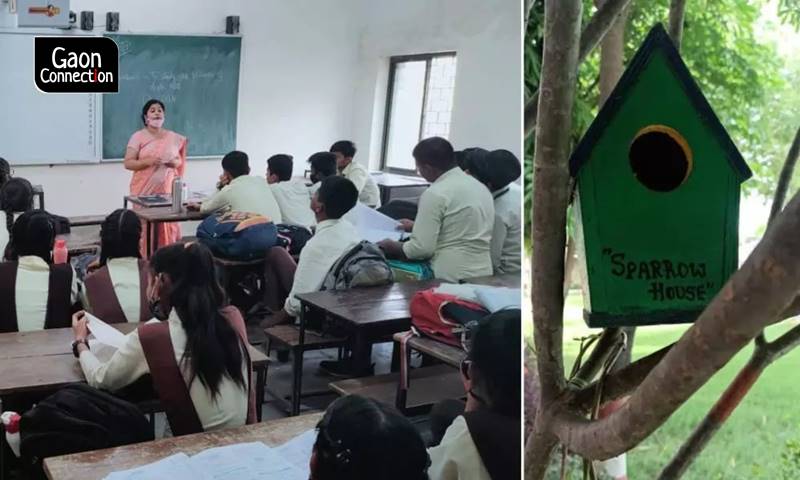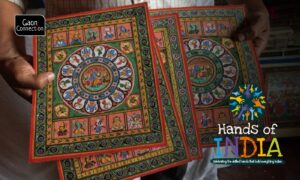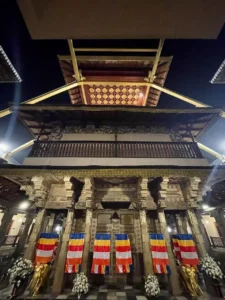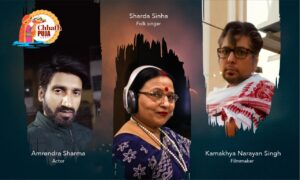Satna, Madhya Pradesh
If every other Class 12 student is busy poring over books and racing to finish portions for the board exams, Archana Shukla’s students also set aside some time to make boxes for house sparrows to nest in. They place these wooden boxes in trees and homes in nearby localities so that sparrows have a safe place to roost.
The house sparrow has been placed on the red list by the IUCN [International Union for Conservation of Nature]. It has been included in the low-conservation concern category.
Shukla, who has a PhD in ornithology, is a secondary teacher at the government higher secondary school, Satna, Madhya Pradesh. In her biology classes, she imparts a deep love for house sparrows and nature among her students.
Also Read: The Little Brown Jobs that flit about in winter
It all began 11 years ago when Shukla read about a white crow spotted by rickshaw driver Mohammad Islam in Madhavgarh near Satna. “I was intrigued, because I’d only seen and heard about the black crow. I spoke to Mohammad, and developed a deep interest in birds and conservation. I pursued my doctorate in the field too,” 38-year-old Shukla told Gaon Connection.
Shukla has been working in the field of sparrow conservation for the past seven years and has helped build more than 200 nests, besides speaking to her own students and others about the need to look out for sparrows.
“The Nature Forever Society, Nashik (Maharashtra), has done a lot of work in collaboration with a French NGO. I was motivated to do similar work,” Shukla said.
“Archana Ma’am taught us a lot about sparrows as well as other birds and their conservation,” Vivek Singh, a former student of Shukla, who now works as a testing assistant with the Madhya Pradesh Transmission Company, told Gaon Connection.
“A class used to be divided into four sections of forty students each. We all made sparrow boxes and placed them in and around the school in the villages of Karahi Khurd, Podi Garada, Bhatigawan, Uchehra, Gadauli and Bara,” Singh added.
The sparrow needs little to thrive — some grain, water and a tiny box to protect it from predators. Shukla said that in village houses, sparrows craft a nest with straw and grass in a corner of the house or below the thatched roof.
“Concrete houses, which are getting more popular, pose a problem. Sparrows are not expert nest makers like other birds, so they look for places where they can place together a few straws and build nests,” she said.
Before joining government service, Shukla worked in Lovedale School in Satna. Vinayak Chamadia, who was her student there, still remembers how she infused in students a love for sparrows. In 2019, Chamadia cleared the Union Public Service Commission (UPSC) exam, and spoke about his teacher in his interview. “When asked about the practical nature of the new education system, I cited Maam’s example to show how a teacher can not only educate society but also contribute towards environmental protection,” he told Gaon Connection.
Shukla said house sparrows shared a centuries-old relationship with humans, especially farmers. “They built their nests in the trees lining the fields. Their chicks grew up there. The worms in the soil were a ready source of protein. By eating them, they protected the field,” she pointed out.
However, the use of pesticides exterminated a food source. Trees were felled, and that brought down the population of house sparrows, Shukla added.
Dilsher Khan of Satna, who used to repair punctures, now works extensively to protect house sparrows. He said that with changing lifestyles, the natural sync between humans and sparrows was disturbed.
“Sparrows cohabit with humans. Earlier, we would sort grains and sprinkle the rest on the ground — this was food for sparrows. Now we buy pre-packaged, cleaned grains. This makes it incredibly difficult for the birds to find grains. If we wish to continue listening to their chirpy cheeping, we must find a way to cohabit again,” Khan told Gaon Connection.



















